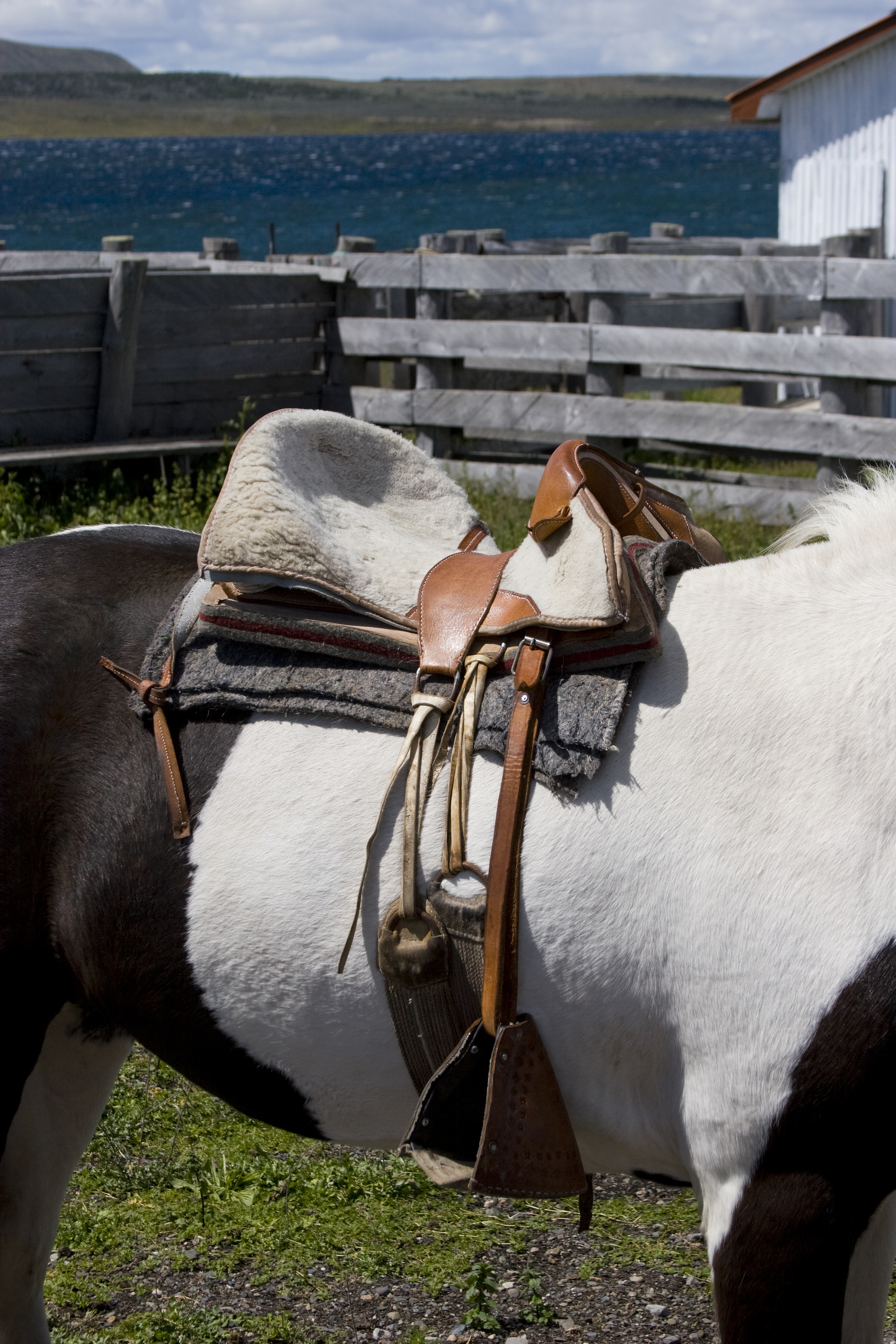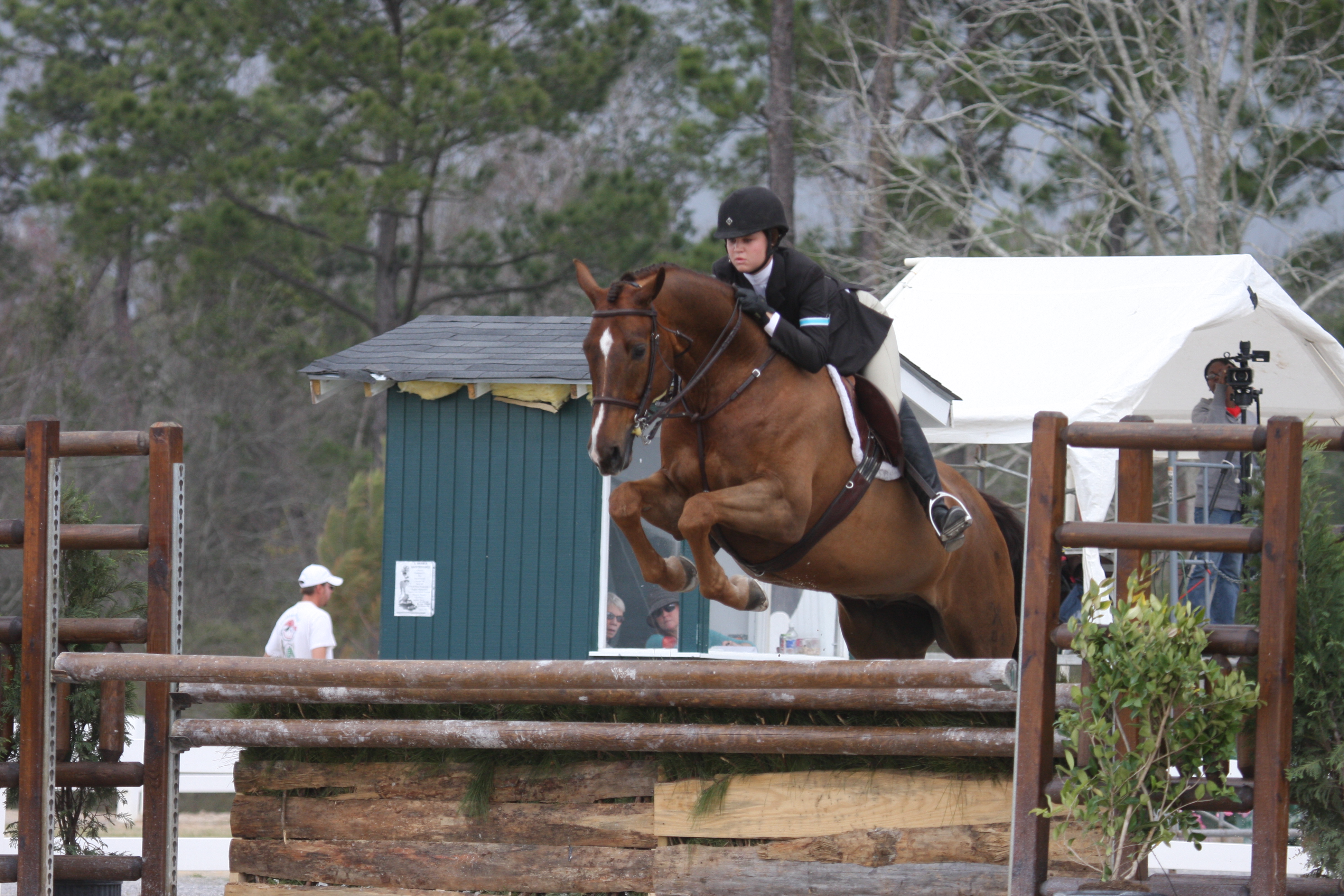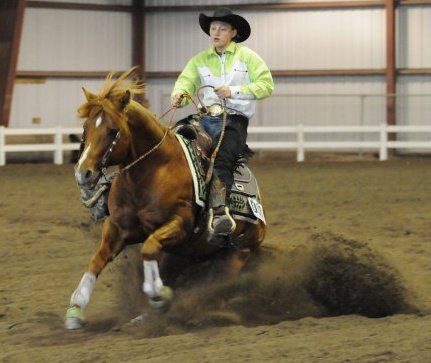|
Rein-back
"Rein-back" is a dressage term to indicate the two-beat movement in which a horse is asked to back up. The horse picks up and sets down its feet almost in diagonal pairs, and moves straight backwards with the line of his forelegs following those of his hind. The horse should remain on the aids during the rein-back. The rein-back should be practiced sparingly, as it can easily over-stress the horse's back and joints. This is especially true if the rider tries to force the horse into the movement. Asking for the rein-back To perform the rein-back, the rider applies both leg aids and a resisting hand. The leg asks the horse to move, but the hand prevents the horse from going forward, so it instead releases that energy in a step back. As soon as the horse begins to step back, the aids are released. The rein-back should be performed in a straight line, with the rider's legs used softly behind the girth to keep the hindquarters straight. The upper body of the rider stays upright, lean ... [...More Info...] [...Related Items...] OR: [Wikipedia] [Google] [Baidu] |
Dressage
Dressage ( or ; , most commonly translated as "training") is a form of horse riding performed in exhibition and competition, as well as an art sometimes pursued solely for the sake of mastery. As an equestrianism, equestrian sport defined by the International Federation for Equestrian Sports, International Equestrian Federation, dressage is described as "the highest expression of horse training" where "horse and rider are expected to perform from memory a series of predetermined movements". Competitions are held at all levels from amateur to the Olympic Games and World Equestrian Games. Its fundamental purpose is to develop, through standardized progressive training methods, a horse's natural athletic ability and willingness to perform, thereby maximizing its potential as a Equestrianism, riding horse. At the peak of a dressage horse's gymnastic development, the horse responds smoothly to a skilled rider's riding aids, minimal aids. The rider is relaxed and appears effort-free w ... [...More Info...] [...Related Items...] OR: [Wikipedia] [Google] [Baidu] |
Horse
The horse (''Equus ferus caballus'') is a domesticated, one-toed, hoofed mammal. It belongs to the taxonomic family Equidae and is one of two extant subspecies of ''Equus ferus''. The horse has evolved over the past 45 to 55 million years from a small multi-toed creature, '' Eohippus'', into the large, single-toed animal of today. Humans began domesticating horses around 4000 BCE in Central Asia, and their domestication is believed to have been widespread by 3000 BCE. Horses in the subspecies ''caballus'' are domesticated, although some domesticated populations live in the wild as feral horses. These feral populations are not true wild horses, which are horses that have never been domesticated. There is an extensive, specialized vocabulary used to describe equine-related concepts, covering everything from anatomy to life stages, size, colors, markings, breeds, locomotion, and behavior. Horses are adapted to run, allowing them to quickly escape predator ... [...More Info...] [...Related Items...] OR: [Wikipedia] [Google] [Baidu] |
Riding Aids
Riding aids are the cues a rider gives to a horse to communicate what they want the animal to do. Riding aids are broken into the ''natural aids'' and the ''artificial aids''. Natural aids ''Natural aids'' are those of the rider's body, and should be used for the majority of the cues to the horse. Overuse of any aid can be detrimental to the training of the horse, but in general harsh or rough hands are considered the worst crime a rider can commit using the natural aids. Mastering and refining these natural aids, often alongside artificial ones, constitutes a significant portion of a rider's challenge in achieving true competence. The natural aids include the legs, hands, weight, and voice. It is important to remember that the aids are used in a spectrum, from very light to very powerful, depending on the response desired. A very sensitive horse may readily jump forward from light touch of the leg, while a horse that is habituated to leg pressure may require a kick to get the ... [...More Info...] [...Related Items...] OR: [Wikipedia] [Google] [Baidu] |
Girth (tack)
A girth, sometimes called a cinch (Western riding), is a piece of equipment used to keep the saddle in place on a horse or other animal. It passes under the barrel of the equine, attached to the saddle on both sides by two or three leather straps called billets. Girths are used on Australian and English saddles, while western saddles and many packsaddle, pack saddles have a cinch, which is fastened to the saddle by a single wide leather strap on each side, called a latigo leather, latigo. Retrieved on 17 March 2009 Although a girth is often enough to keep a well-fitting saddle in place, other pieces of equipment are also used in jumping or speed sports such as polo, eventing, show jumping, and fox hunting; or on rough terrain such as trail riding. These include Breastplate_(tack), breastplates, surcingle, overgirths, cruppe ... [...More Info...] [...Related Items...] OR: [Wikipedia] [Google] [Baidu] |
Horse Tack
Tack is equipment or accessories equipped on horses and other equines in the course of their use as domestication of the horse, domesticated animals. This equipment includes such items as Saddle, saddles, Stirrup, stirrups, Bridle, bridles, Halter, halters, Rein, reins, Bit (horse), bits, and harnesses. Equipping a horse is often referred to as tacking up, and involves putting the tack equipment on the horse. A room to store such equipment, usually near or in a stable, is a tack room. Saddles Saddles are seats for the horseback riding, rider, fastened to the horse's Back (horse), back by means of a ''Girth (tack), girth'' in English-style riding, or a ''cinch'' in the use of Western tack. Girths are generally a wide strap that goes around the horse at a point about four inches behind the forelegs. Some western saddles will also have a second strap known as a ''flank'' or ''back cinch'' that fastens at the rear of the saddle and goes around the widest part of the horse's belly. ... [...More Info...] [...Related Items...] OR: [Wikipedia] [Google] [Baidu] |
Equitation
Equitation is the art or practice of horse riding or horsemanship. More specifically, equitation may refer to a rider's position while mounted, and encompasses a rider's ability to ride correctly and with effective aids. In horse show competition, the rider, rather than the horse is evaluated. Such classes go by different names, depending on region, including ''equitation classes'', ''rider classes'', or ''horsemanship classes.'' Judging criteria covers the rider's performance and control of the horse, use of riding aids, proper attire, correct form, and usually factor in rider poise and the cleanliness and polish of horse, rider and equipment. The performance of the horse is not judged ''per se'', but a poorly performing horse is considered to reflect the ability of the rider. Equitation classes occur in the Hunt seat, Saddle seat, Dressage, and Western disciplines. A good equitation rider is always in balance with the horse, maintains a correct position in every gait, moveme ... [...More Info...] [...Related Items...] OR: [Wikipedia] [Google] [Baidu] |
Eventing
Eventing (also known as three-day eventing or horse trials) is an equestrian event where the same horse and rider combination compete against other competitors across the three disciplines of dressage, cross-country, and show jumping. This event has its roots in a comprehensive cavalry test that required mastery of several types of riding. The competition may be run as a one-day event (ODE), where all three events are completed in one day (dressage, followed by show jumping and then the cross-country phase) or a three-day event (3DE), which is more commonly now run over four days, with dressage on the first two days, followed by cross-country the next day and then show jumping in reverse order on the final day. Eventing was previously known as Combined Training, and the name persists in many smaller organizations. The term "Combined Training" is sometimes confused with the term "Combined Test", which refers to a combination of just two of the phases, most commonly dressage a ... [...More Info...] [...Related Items...] OR: [Wikipedia] [Google] [Baidu] |
Combined Driving
Combined driving (also known as horse driving trials) is an equestrian sport involving driving (horse), carriage driving. In this discipline, the driver sits on a vehicle drawn by a single horse, a pair or a team of four. The sport has three phases: dressage, cross-country marathon and obstacle cone driving — patterned after the mounted equestrian sport of eventing. It is one of the ten international equestrian sport horse disciplines recognized by the International Federation for Equestrian Sports, Fédération Équestre Internationale (FEI). Combined driving became an FEI discipline in 1970 when Prince Philip, Duke of Edinburgh, the then-president of FEI, produced the first rule book. Competitor Driver The driver controls the horse or horses through the reins, whip and voice. Although there is a seat next to the driver on some sport carriages — jokingly called the suicide seat — it is not generally occupied in competition if there is a stand or seat behind the driver f ... [...More Info...] [...Related Items...] OR: [Wikipedia] [Google] [Baidu] |
Reining
Reining is a western riding competition for horses in which the riders guide the horses through a precise pattern of circles, spins, and stops. All work is done at the lope (a version of the horse gait more commonly known worldwide as the canter), or the gallop (the fastest of the horse gaits). Originating from working cattle, reining requires the horse to be responsive and in tune with its rider, whose aids should not be easily seen, and judges the horse on its ability to perform a set pattern of movements. The horse should be willingly guided or controlled with little or no apparent resistance and dictated to completely. A horse that pins his ears, conveys a threat to his rider, refuses to go forward, runs sideways, bounces his rear, wrings his tail in irritation, or displays an overall poor attitude is not being guided willingly, and is judged accordingly. If a horse jogs or breaks gait it is a 0. Origins Throughout the history of the Americas, dating back to the earliest S ... [...More Info...] [...Related Items...] OR: [Wikipedia] [Google] [Baidu] |




